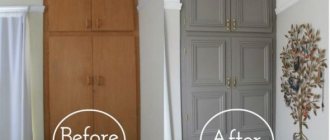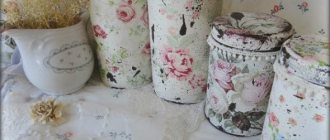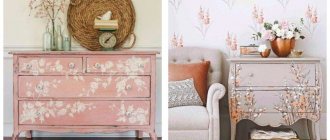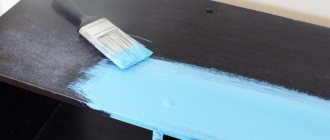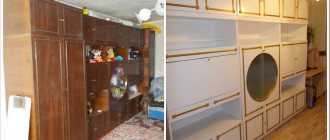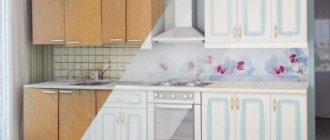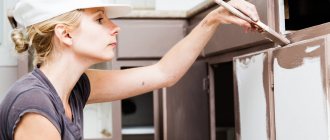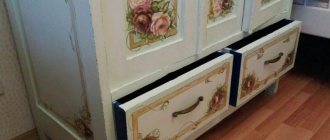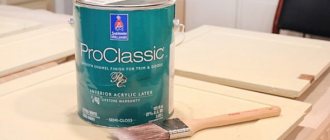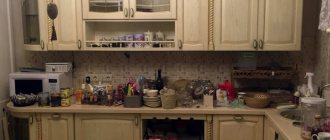Key factors that can pose a threat to wood furniture are high humidity, exposure to UV rays, temperature changes, mechanical damage, fungus and mold. To create maximum protection and attractiveness, special paints and varnishes are used. How to paint old furniture so that it lasts for some time without irritating the eye or spoiling the overall picture of the interior? It’s very simple, and there are many restoration methods. Let's look at the simplest and most accessible ones. But first, let’s figure out what needs to be done for this, what tools and consumables to stock up on.
When does coloring make sense?
After you take a closer look at the price tags in furniture stores, you begin to think about alternative ways to update your interior. A good way to update would be to repaint existing furnishings. There are several reasons why people think about painting furniture and begin to study the issue in detail:
- I would like to update the furniture in my dacha. Most country house sets are made up of outdated furniture of different styles and colors. The update will help bring all items to a single style, making the interior harmonious and cozy.
- It's a shame to throw away your old headset. Many sets left over from Soviet times are durable and can last for decades. But their surface has long lost its attractiveness, and the objects themselves look obsolete; Restoration and painting (possibly with a color change) will help extend their life.
How to refresh an old item Source aviarydecor.com
- The house has an inherited rare wardrobe or retro chest of drawers. Antique furniture is valuable for its original appearance, often more refined than modern models, but its appearance is far from perfect. Skillful restoration will transform an old item beyond recognition and make it a decoration for any living room or bedroom.
- You want to refresh the interior, but you are not mentally prepared for a full renovation. In this case, point changes are used. They often change the color of one wall, make it an accent wall, and purchase new textiles and lamps. An effective way would be to repaint furniture in a new, sometimes unexpected color: when a brown cabinet turns white or olive, the interior is transformed beyond recognition.
- I want to change my style. They resort to artificial aging of facades when they want to decorate the interior with vintage notes (for example, Provence or shabby chic). A chest of drawers or a wardrobe begins to resemble an antique thanks to a special painting technology. A decorative layer with noble cracks can be obtained in several ways.
Nightstand with aged effect Source luniqueblog.com
What we paint: getting ready for the process
Before wondering how to repaint furniture a different color, you need to determine what material you will have to deal with. Solid wood furniture is quite rare; It is easy to paint a prepared wooden surface. The only problem that may arise after applying paint or varnish is the raising of pile. To prevent this, the coating is sanded after the first priming.
More often, Soviet-made items made from chipboard and MDF need updating. To work with them, you should stock up on a respirator, gloves, and provide ventilation. The direction of action is determined by the type of particle board:
- Painted. You can remove a layer of paint (as well as varnish) using a solvent; The procedure will take more than one hour, plus you will have to spend money on chemicals. There is an alternative cleaning option - a spatula and a hair dryer.
Fashionable white Source kammerat.co
- Lacquered. Repainting old varnished items is harder than any other. According to the technology, the varnish was applied in several layers, and its complete removal can take a lot of time. If the surface has scratches or other damage, it is much easier to polish it while maintaining the original color.
- Laminated. The technology for making furniture from laminated chipboard is used in modern production. The surface is covered with a polymer film, creating a durable and reliable layer. The process of restoring items made from laminated chipboard is very difficult; the coating cannot be completely removed, and there is a high risk of damaging the base material.
Fashionable black Source pinimg.com
- Laminated. The laminating process involves applying glue to chipboard or MDF, followed by pressing on decorative film, budget material on a paper or fleece basis. The paper covering is the most unreliable, it is not difficult to clean it, but in addition it is necessary to remove the adhesive layer. After stripping the glue, the item is ready to apply new decor.
- Veneered. Products made from chipboard covered with natural wood veneer are high-quality products and an alternative to things made from solid natural wood. The decorative layer is not removed, so restoration is carried out only with the help of stain and varnish.
Yellow as an interior accent Source foter.com
See also: Catalog of companies that specialize in paints and varnishes and related work
Surface preparation
The preparation process may require all or only some of the following procedures:
- Drying and removing mold. You can’t do without them if the old cabinet has spent many years in the barn; The paint will only adhere well to dry wood. If there are areas affected by mold on the surface, they are washed with water, dried, and then sanded. At the end, the tree is coated with an antifungal drug, covering neighboring areas.
- Processing of knots. This is a problem with almost any new wood. The knots release resin, which prevents the paint from adhering tightly. The resin is removed with a spatula; the knot area can be preheated with a technical hair dryer. Then the area is sanded with sandpaper and further treated with cellulose (or ammonia) solvent.
Sanding Source saymedia-content.com
- Removing the coating. If the old coating (varnish, paint) is partially preserved, it is sanded with sandpaper. If it is cracked or peeling, heating with a technical hairdryer followed by scraping with a spatula will help. The varnish can be pre-softened using a paint remover.
- Putty. It is needed to level the surface and remove chips and cracks. Use a special putty for wood (water-based) to fill the uneven areas. Then the application area is carefully sanded with fine-grained sandpaper.
- Degreasing. The wooden surface should not only be dry and smooth, but also frequent, without grease stains or traces of resin. Extraction gasoline or nitro solvent will help wash away dirt.
- Primer. It reduces paint consumption, preventing it from being absorbed into the wooden base, and at the same time improves the adhesion (adhesion) of the layers. Before applying the primer (a colorless primer for wood or drying oil is suitable), the surface is cleaned with a brush or vacuum cleaner.
Filling defects Source pitmebel.ru
Step-by-step instructions for repainting
Stages of work:
- wash the item with water and detergent;
- after drying, disassemble into separate elements, remove handles, take out drawers, unscrew legs;
- treat with fine-grained sandpaper to smooth out roughness and remove the old coating;
- cover large cracks with putty;
- stick masking tape on parts that do not need to be painted;
- coat with primer;
- apply paint;
- After the first layer has dried, apply the second, and then, if necessary, the third.
See also
Lessons on creating simple drawings with paints for children and what you can draw
When the paint is completely dry, the furniture is varnished. Metal frames are also sanded, covered with a metal primer, and then painted.
The best way to repaint furniture
The choice of paint and varnish products on the construction market is amazing. The owner of an old cabinet, deciding how to paint chipboard furniture at home in white (or any other) color, will first of all have to decide on the choice of composition.
You can use stain if you only want to tint the material (usually it is chosen for veneered furniture). The varnish is applied in two ways. Usually the varnish layer is the final one; it secures and protects the bottom decorative layer, making it resistant to moisture. Varnish, like wax, can be used independently; this helps maintain the natural wood texture.
Tinting Source pinimg.com
Variety of colors
The color range of paints on the construction market is endlessly varied. If you cannot find a suitable shade, you can always resort to tinting, a technology that allows you to obtain the desired tone. Self-tinting is fraught with pitfalls: if there is not enough paint, it is almost impossible to reproduce the same shade.
When using different compositions, the surface type has different degrees of gloss: matte, semi-matte (satin, silky-matte), glossy. The following types of dyes are suitable for furniture decoration:
- Oily. The paint forms a dense matte layer on the surface, the shade is saturated. A significant disadvantage is the long drying time, coupled with an unpleasant odor that lasts for some time after drying. It is better to work with the oil composition outdoors or in non-residential premises.
Chair update Source ytimg.com
- Acrylic. Furniture acrylic paints are mostly matte, close to natural shades. For anyone wondering how to spray paint white chipboard furniture, water-based acrylic is the ideal choice. It will lie flat and dry quickly, without odor or health consequences. To paint laminated chipboard you will need a composition with increased adhesion, and you should not dilute it with water.
- Alkyd (enamel). Alkyd enamel is harmless, economical in use and does not turn yellow over time. The surface dries quickly and becomes glossy. If the furniture has metal parts, they will be protected from corrosion. Fresh paint has a specific smell.
- Latex (silicone). Water-based paint with artificial latex is environmentally friendly, UV-resistant, and dries quickly (within an hour). The composition is often used for the restoration of veneer furniture. The disadvantage is its high cost, as well as the need for careful surface preparation before application.
Coloring Source diy.obi.ru
Common mistakes
Among the most common mistakes during restoration, it is worth highlighting:
- Discoloration and bleed-through. They can occur due to poor cleaning of the surface from dust and greasy stains. Before you start work, you need to study the painting technology in order to know how to carry it out correctly and strictly adhere to all recommendations. To correct the error, you must identify the source of contamination and remove it. And before repainting, you should always treat the surfaces with a special layer of primer;
- Cracking of painted layers on the outside. The reason for this defect may be the following: the previous layer of paint is too thick, the coloring composition has lost its elasticity and is now unable to either shrink or expand on top of the substrate. A small area can be scraped off, sanded, and painted again. The larger one will have to be cleaned of the coating using a hair dryer and a spatula, primed and repainted again;
- Unpainted areas. This happens because the surface was not properly degreased before painting. It has waxy or oily areas. The coloring composition cannot apply evenly, leaving unpainted areas and spots. Allow the painted surface to dry completely. Sand with sandpaper, wash with soap and water or any detergent, and dry;
- Formation of smudges on a freshly repainted surface. This is a consequence of uneven application of the coloring composition over a wide area or too much dilution with a solvent. The defect can be corrected by sanding the paint with warm soapy water after it has completely dried. Apply the coloring composition again, washing the surface again with warm water and soap, then dry it;
- Freshly applied paint wrinkled. This happens because the top layer dries faster than the bottom layer. Especially large wrinkling occurs on a thick layer;
- Freshly painted furniture takes a very long time to dry. This is most likely caused by improper preliminary preparation or an overly contaminated surface. Water-based paint can take a long time to dry because it is applied in damp or too cold conditions.
Old and worn furniture can sparkle with new colors, becoming the highlight of the interior. You just need to turn on your own imagination, add a creative approach, and in a few hours change it radically. Any decoration technology is appropriate here, the main thing is to use high-quality materials, take your time, and do not treat the work negligently, so as not to correct your own mistakes later.
Principles for choosing paint
An important selection criterion is the place where the furniture will be used. From this point of view, water-based compositions are chosen for home furnishings. They are harmless to health, resistant to abrasion, and the surface painted with them “breathes.”
They act differently if the restored sofa or armchair is planned to be placed on an open veranda. When considering different options for painting a chipboard chest of drawers white, the choice is made in favor of paints with high elasticity. Drying oil-based paints may be a suitable solution, but they take a long time to dry, and under the rays of the sun the oil layer may crack over time.
On the terrace Source pinimg.com
For furniture intended for outdoor use, other compositions with high elasticity are also suitable: alkyd-oil and alkyd. Water-based wood dyes are also intended for exterior use; they are environmentally friendly and preserve the integrity of the layer during changes in temperature and humidity.
Home furniture can be repainted using acrylic, oil or alkyd paint. A composition based on drying oil is affordable, but it is advisable to choose it for working in a vintage style. Based on the totality of its characteristics, acrylic paint is considered the best, and alkyd enamel surpasses it in terms of price/quality ratio and is therefore the golden mean.
Vintage chair decor Source in-stadtmagazine.de
Features of the material
The paint finish protects the surface of interior items from scratches, cracking and abrasion. Using a coating, you can preserve the natural beauty of wood, tint or emphasize the natural pattern. Furniture paints will stop the destruction of wood and protect metal facades from corrosion.
Characteristics of species Source ru4.anyfad.com
Depending on the chosen finish and the number of layers, it is possible to radically transform the surface. Based on the type of structure, a distinction is made between transparent (varnishes, impregnations, azures) and solid ones. Modern materials are:
- glossy;
- semi-matte;
- satin;
- matte.
Protective finishing will protect tables and chairs from the negative effects of ultraviolet radiation and rain. Thanks to the moisture-resistant coating, you can install shelves or a chest of drawers in the bathroom. The boring color of plastic or wooden interior items can be easily changed using tinted paint.
Beautiful furniture covering Source spirossoulis.com
How to paint correctly: secrets of painting and decor
Tips on how to repaint old furniture white step by step include all the important steps, from surface preparation and paint selection to painting technology. However, important little things that simplify the process and improve the result are often overlooked. The following tips will undoubtedly be useful:
- It is useful to stock up on several brushes of different sizes (thicknesses). It is convenient to handle large surfaces and decorative elements using a spray gun.
- The wooden surface is painted along the grain with smooth movements, the brush is lowered into the jar no more than a third.
- If there are fittings on the furniture façade (handles, locks), they are removed during painting or wrapped with mounting tape.
In the kitchen with a touch of Provence Source archidea.com.ua
- Aerosol paint is used uneconomically, for example, when painting a chair. But it is convenient to work with fittings or decorative elements. Color is applied to small details with an aerosol faster and more evenly than with a brush.
- Using spray paint and a stencil, you can apply a pattern to a wooden surface. For example, a plastic lace napkin is suitable as a stencil.
- Furniture in retro or Provence style can be decorated with decorative stucco molding made of polystyrene foam or polyurethane. The decor is attached with wood glue; paint the product after the glue has dried.
- Masking tape is a useful addition to the job. It will protect the already painted part from getting another dye.
Fittings are important for style Source mydecorative.com
We fix minor defects without removing old varnish
Restoring the polished surface of an object is possible using different methods. The following work options can be distinguished:
- Small stains on the base and faded color can be restored with products containing orange oil, which are created for wooden products. To apply the solution evenly, take a spray gun, then you need to rub the composition with a cotton rag;
- Stains can be removed using a retouching marker, wax, or denatured alcohol. First, the base is degreased with dishwashing detergent; when the base is dry, the marks are wiped with a rag soaked in alcohol. Deeper scratches can be removed with a marker; wax, spread with a rag, will help restore the gloss;
- Irregularities caused by small scratches can be removed using a manicure file;
- If swelling from water is detected, rub the area with a solution made from olive oil and salt. The composition should saturate the surface within half an hour. Afterwards, the remains are wiped, the area is covered with wax and polished;
- The chips are covered with a putty solution for wooden materials. After drying the layer, level the areas with sandpaper.
The chips are covered with a putty solution for wooden materials.
Briefly about the main thing
You can give obsolete furniture a new life by painting it a different color. The method is also suitable if you want to change your boring interior without going into renovations. Before painting, furniture must be prepared and the type of surface determined.
Preparation is a multi-step process, and skipping its stages is highly undesirable. Different types of paint and varnish products are used for repainting. Stain tints the material, varnish and wax complete the process. The main composition, paint, is chosen based on its performance characteristics. To ensure that the paint lays evenly, surface defects must first be repaired and work in good lighting.
Ratings 0
Varnishing
Apply 2-3 layers of varnish to the painted and cleaned surface. Each layer must dry for at least 40 minutes. For varnishing, brushes are used or a special tampon is made - cotton wool is dipped into the composition and wrapped in linen cloth. The coating is applied evenly, using blotting movements and in any direction.
